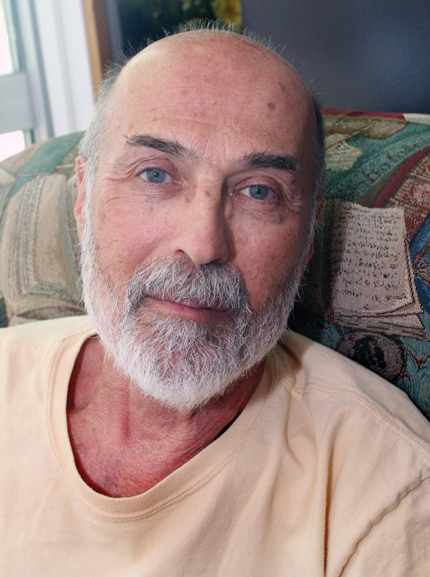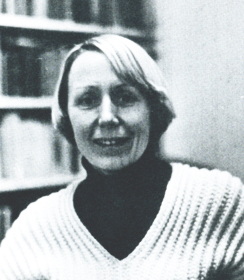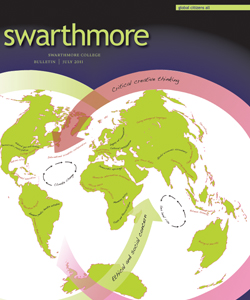Professors Retire from Swarthmore
“I’M GLAD I'VE BEEN AT SWARTHMORE”

Professor Charles Kelemen played a pivotal role in developing computer science curricula for liberal arts institutions.
Charles Kelemen, Edward Hicks Magill Professor of Computer Science, has been granted tenure three times but has given it up twice. Lucky for Swarthmore, here is where he decided to stay.
In 1984, Kelemen arrived on campus to develop a concentration in computer science (CS); by 2001, he had created a department. With a doctorate in math—there were no Ph.D. programs in CS when he began graduate school—Kelemen gained the knowledge to build a CS program at Ithaca College by sitting in on, one-by-one, all of nearby Cornell University’s graduate computing courses.
Kelemen has played a pivotal role in formulating computer science curricula specifically for liberal arts institutions and is a founding member of the Liberal Arts Computer Science Consortium. Last year, he received the Distinguished Educator Award from the Association for Computer Machinery (ACM) for his creativity, leadership, and dedication to the field.
“Our department is highly regarded in the field of computer science education because of Charles’s work and leadership,” says Tia Newhall, associate professor and chair.
According to Professor of Computer Science Lisa Meeden, Kelemen has mentored hundreds of students through career choices in industry and graduate school. His former students work at Google, Amazon, and Microsoft and have received Ph.D.s from every top graduate school, including Carnegie Mellon, MIT, and Stanford.”
Theory of computation and algorithms have been the focus of Kelemen’s research. In retirement, however, he expects to do “soft-core” research, answering the questions: What is the definition of computer science? What is its core?
Retirement will also include reading, sailing his “runabout” on the eastern end of Lake Ontario, and getting back into music. A boy soprano from the second grade and a tenor when his voice changed, he hasn’t done music—other than listening—for 35 years. Two years ago, he purchased a digital electric organ that, he says, “sounds like a recording of a pipe organ.” In the spring, while teaching part time, he auditioned and was chosen to play a Peer in the Savoy Company’s [Philadelphia] rendition of Gilbert and Sullivan’s Iolanthe. “It was a wonderful experience,” says Kelemen. “In the fall, I plan to look for another singing opportunity.”
Leaning back in his chair, warm sun casting shadows across his face, Kelemen says: “This is a place where morale is high; where people feel good about what they’re doing.
“Boy, I’m glad I’ve been at Swarthmore!”
—Susan Cousins Breen
VOWELS AS JUICY AS GOOD PLUMS

Elke Plaxton, shown in this photo from the 1978 Halcyon, joined the faculty in 1971 as a lecturer in German.
Lecturer in German Elke Plaxton has retired after 40 years at the College. Although she declined to be interviewed, colleagues, friends, and students were delighted to reminisce about her.
Plaxton often ate lunch in the Theresa Lang Garden of Fragrance with Michael Jones, director of the Language Resource Center.
Marion Faber, Scheuer Family Professor Emerita of Humanities and Professor Emerita of German, introduced Jones to the woman who was to become his lunch companion and valued friend. Jones says: “We spoke German for a few minutes, she welcomed me to Swarthmore, then looked at the new equipment and said, ‘It’s all very nice, but I’m not good with technology.’ Elke may not have known much about technology, but she became a pretty creative user over the years.”
Faber, who joined the faculty in 1979, was introduced to Plaxton by the late Associate Professor of German Eugene “Gene” Weber. “He said I’d find Elke to be a fabulous teacher and collaborator,” Faber says, “but that she was a very conservative, reserved woman in the German style, so I shouldn’t be surprised if we would be using the [formal] Sie [you] form in our interactions. Such was indeed the case at the beginning. That’s why my most vivid memory of Elke is the wonderful feeling of trust I experienced, when we subsequently—not so terribly long afterwards—evolved to the [informal] du. We’ve been using it for more than 30 years since then in our fun-filled collaborative teaching, and I hope that we’ll continue to do so.”
Jonathan Franzen ’81, a former student, wrote Plaxton into his first book The Discomfort Zone: “The teacher I adored was the drill instructor, Frau Plaxton, a woman of limitless patience and beautifully chiseled Nordic looks. I saw her every Tuesday and Thursday at 8:30 a.m., an hour made tolerable by her affectionate, bemused way of saying ‘Herr Franzen,’ when I walked into the room…. The German vowels and consonants she over-pronounced for heuristic purposes were as juicy as good plums.”
—Carol Brévart-Demm
Also retiring from the faculty in June was Robert DuPlessis, the Isaac H. Clothier Professor of History and International Relations. DuPlessis asked the Class of 2011 at its baccalaureate service, “Why do we get dressed up in archaic robes, parade in ordered processions, and listen to lectures—and why do we do all this at Swarthmore, where dress is usually informal, where most people march to their own drummer, and where we pride ourselves on the give and take of discussion?” Watch his answer to this rhetorical question at www.swarthmore.edu/duplessis.xml. And look for a longer article about DuPlessis’ 38-year career at Swarthmore in the October Bulletin.
 Email This Page
Email This Page